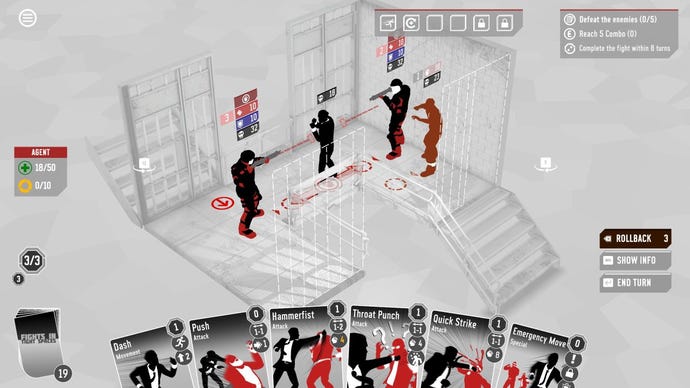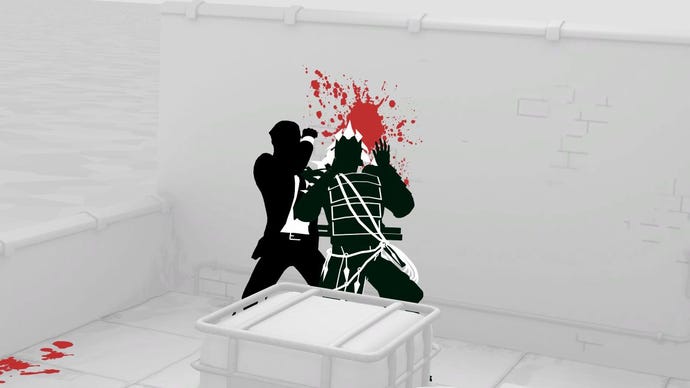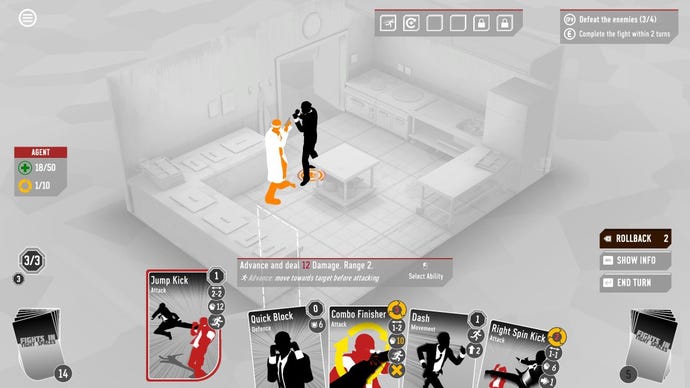Fights In Tight Spaces review: a unique twist on the deckbuilding genre that pulls one too many punches
Plenty of time to die
Fights In Tight Spaces is about one specific trope that all the spy movies I’ve seen love to use: our main character’s got to a part in the story where they can relax a bit, inevitably they let their guard down, and on cue, a mystery assassin erupts from the shadows to take advantage of the opportunity. The hero’s got nothing but their brawn to make it out, but then, surprise! They actually use brains instead. Nobody ever saw it coming. The thing is, watching those movies, we all know the main character’s not really going to die. I mean, it’s called The Bourne Identity. There’d be no movie without a Bourne! (The Jeremy Renner one doesn’t count.)
Instead of non-stop fast and frenetic action, Fights In Tight Spaces goes for a different approach, and dissects those same action sequences into a turn-based battle. Rather than the scene being a choreographed piece of stunt and camera work that’s over in a matter of seconds, it’s a roguelike deckbuilder that puts the player in charge of every minute decision an action hero would have to make in one of those situations. Which means, if that untouchable main character dies at any point, it was because of what you did. Most of the time anyway.
In Fights In Tight Spaces, you play as an anonymous spy known only as Agent 11, who’s employed by an equally mysterious espionage organisation. Your handler provides you with various dossiers on crime syndicates for you to take down, which in turn become the procedurally generated levels you make your way through. You get into fights, you improve your deck, and then eventually face off against a boss. It’s very Slay The Spire-y.
But Fights In Tight Spaces trades in the magic and swordplay for just, straight up, punching a dude in the face. It's not entirely dissimilar to John Wick Hex, but all of your attacks come in the form of cards. As juvenile as it sounds, every attack you would ever want in a game like this is here. And they’ve all been realised fantastically through some cartoon-y yet visceral animation work. You can headbutt enemies, throw them into walls, and even counter attacks as they come in towards you. Even Guile from Street Fighter’s Flash Kick is in here. Plus, for the deadlier blows you land, the game will cut to a close-up angle to give you a front row seat to your own handiwork. It’s so much fun kicking enemies across a room, then watching their bodies ragdoll and crumple up on the floor.

The twist is that each fight takes place in a tiny closed-off 3D isometric plane, rather than a 2D one, so managing your positioning and the space around you is equally as important as your deck building skills. As well as attack and defense-based cards, you have to think about including movement ones, and there are also combinations of both available, like jumping towards an enemy to punch them right in the chest. Later down the line some areas mix this up by having semi-open environments, like a tram car with its doors open, or a railing blocking you off instead of a wall. If you can find a way to push, kick, or throw an enemy out of the map, it’s an instant kill.
A lot of the time though, using your movement creatively is just as much, if not more, satisfying than regular combat. That’s because the game provides you with the foreknowledge of what attacks the enemies are going to do in their next turn, as well as displaying exactly where they’re going to hit, like in Into The Breach. So, if you (quite literally) play your cards right, you could end up tricking two enemies into shooting each other, while you’ve slipped past them and are busy dealing with a third. This is such a great idea, and I got into it way more than directly attacking enemies. Every fight is like picking up a half-complete game of chess and trying to finish it. I highly recommend saying “why are you hitting yourself?” in an overly sarcastic and whiny voice as you do it.
Fights In Tight Spaces visual style is immediately eye-catching. It seems inspired by the CGI intro to Casino Royale (or perhaps Superhot, if we're comparing it to other games) and as minimalist as it is, it never gets boring. You battle through tons of unique locations, like a motorcycle club, a prison stairwell, even a pub, and they all have surprisingly stark identities. It's supported by great lighting work, too, which adds a welcome layer of depth to the game’s look.

There’s such a brilliant core to Fights In Tight Spaces, genuinely unlike anything else I’ve come across, but unfortunately it’s directly connected to one of the biggest flaws the game has: there’s barely any replayability to it. To be fair, you do unlock new starter decks as you progress through the game, as well as a card compendium for you to fill in, both of which are acquired through an XP system. They’re kind of pointless though, because you already have access to every single card in the game from the very start, since they appear as rewards from fights, so nothing really changes between runs.
The other deckbuilders I’ve played, like Slay The Spire or Monster Train, usually force me to drastically change how I think about the game depending on the playstyle I’ve chosen. In Fights In Tight Spaces, it felt like if I tried to play in any way besides the initial balanced attack and defense deck, I was at a disadvantage. If I went for a deck that made enemies bleed and take damage over time, I’d miss out on bonus objectives to end fights quickly. If I played with an aggressive deck, I’d die immediately in later boss battles, because of their giant HP bars tanking my hits. In the end, it felt fairly pointless experimenting with the various deck archetypes, because whenever I did, the game was ironically fighting against me because of it.
There’s a daily challenge to incentivise you to keep playing, but all it made me realise is that I don’t think procedural generation benefits this game that much. After a few hours, the fights started to blend together for me, and the random enemy encounters didn't shake up enough to keep it feeling fresh. There are only so many ways you can place a bunch of enemies in a small enclosed map. I beat the game on, like, my sixth run (which admittedly took me several hours), and after that I had pretty much seen everything it had to offer. There weren't branching levels to explore, and there weren't any characters with new playstyles either.

Fights In Tight Spaces does have multiple difficulty settings, though, and they ended up resolving this problem for me, because they’re designed to fundamentally change how the game works. The “Classic Plus” mode adds the ability to retry rooms if you die, and you’re allowed to undo up to three moves per encounter. This turned the whole affair into a puzzle game, and I enjoyed it way more as a head-scratcher, rather than planning around permadeath.
Weirdly, the thing that felt most underdeveloped was the setting. As integral to the game as it is, there’s not really a story, and outside of brief humourous conversations between levels Agent 11 is dead silent. I don’t think there’s anything wrong with a silent protagonist in the right game, but I associate this kind of action spy film tone far more with plot twists, campy characters, and on-the-nose dialogue - at least as much as, if not more so, than the action sequences in them. I’m not asking for the game to be an Austin Powers adaptation but toppling an entire crime family without even saying a single word to their leader is extremely strange.
Still, as negative as I’ve been, I would recommend Fights In Tight Spaces wholeheartedly as it is, because the action at the heart of it is honestly incredible. When everything’s going right, it engages my brain like I’m doing a particularly hard sudoku. The problem is there isn’t much besides that going on. The whole game feels like it should be one of the best things I played this year, but somehow I came away from it saying just “okay.”



